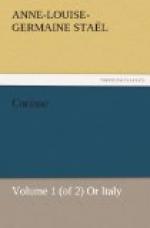Corinne was of opinion that the expression of modern painters was often theatrical, and that it bore the stamp of their age, in which was no longer found, as in Andrea Mantegna, Perugino, and Leonardo da Vinci, the unity and simplicity which characterised the repose of the ancients; a repose to which is joined that profundity of sentiment which is the characteristic of Christianity. She admired the artless composition of Raphael’s pictures, especially those in his first manner. All the figures are directed towards one principal object, without any contrivance on the part of the artist to group them in various attitudes in order to produce a laboured effect. Corinne said that this sincerity in the arts of the imagination, as well as in every other, is the true character of genius; and that studied efforts for fame are almost always destructive of enthusiasm. She maintained that there was rhetoric in painting as well as in poetry, and that all those who could not embody character called every accessory ornament to their aid, uniting rich costumes and remarkable attitudes to the attraction of a brilliant subject, whilst a single Virgin holding a child in her arms, an attentive old man in the Mass of Bolsena, a man leaning on his stick in the School of Athens, or Saint Cecilia with her eyes lifted up to heaven, produced the deepest effect by the expression of the countenance alone. These natural beauties increase every day more and more in our estimation; but on the contrary, in pictures done for effect, the first glance is always the most striking.
Corinne added to these reflections an observation which strengthened them: which was, that the religious sentiments of the Greeks and Romans, and the disposition of their minds, being in every respect absolutely foreign from ours, it is impossible for us to create according to their conceptions, or to build upon their ground. They may be imitated by dint of study; but how can genius employ all its energies in a work where memory and erudition are so necessary? It is not the same with subjects that belong to our own history and our own religion. Here the painter himself may be inspired; he may feel what he paints, and paint what he has seen. Life assists him to imagine life; but in transporting himself to the regions of antiquity, his invention must be guided by books and statues. To conclude, Corinne found that pictures from pious subjects, impart a comfort to the soul that nothing could replace; and that they suppose a sacred enthusiasm in the artist which blends with genius, renovates, revives, and can alone support him against the injustice of man and the bitterness of life.




